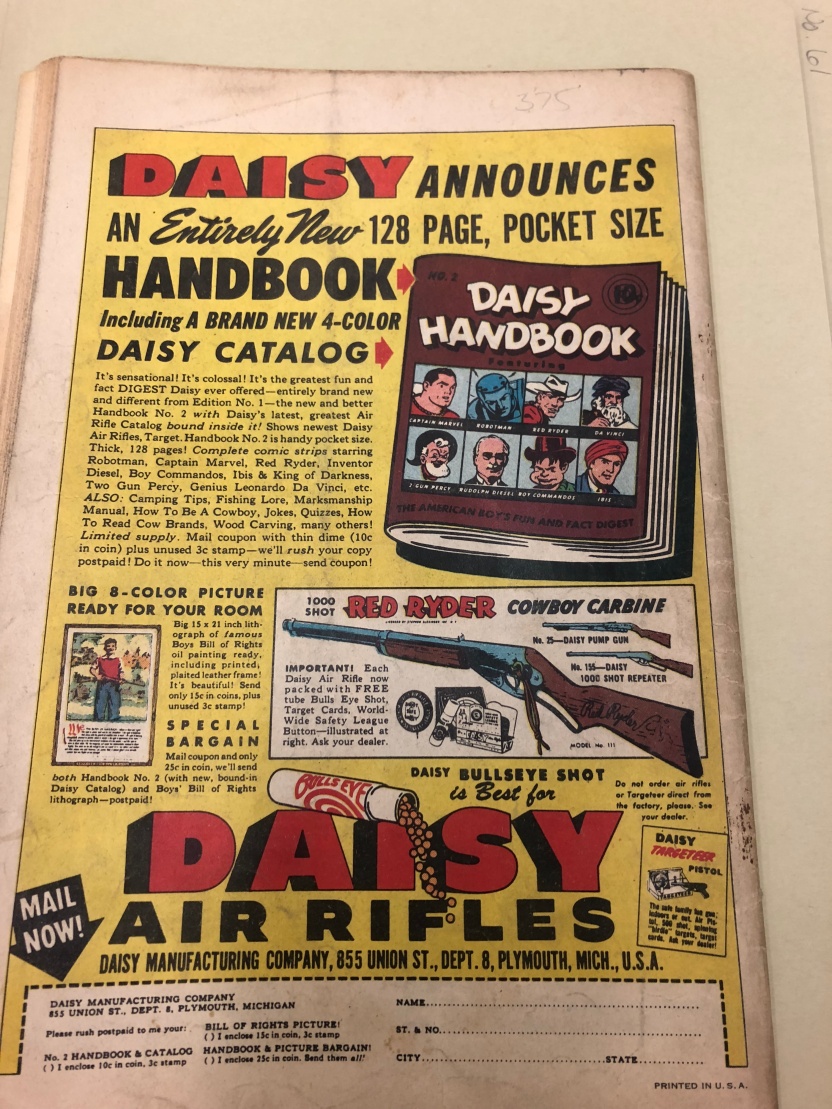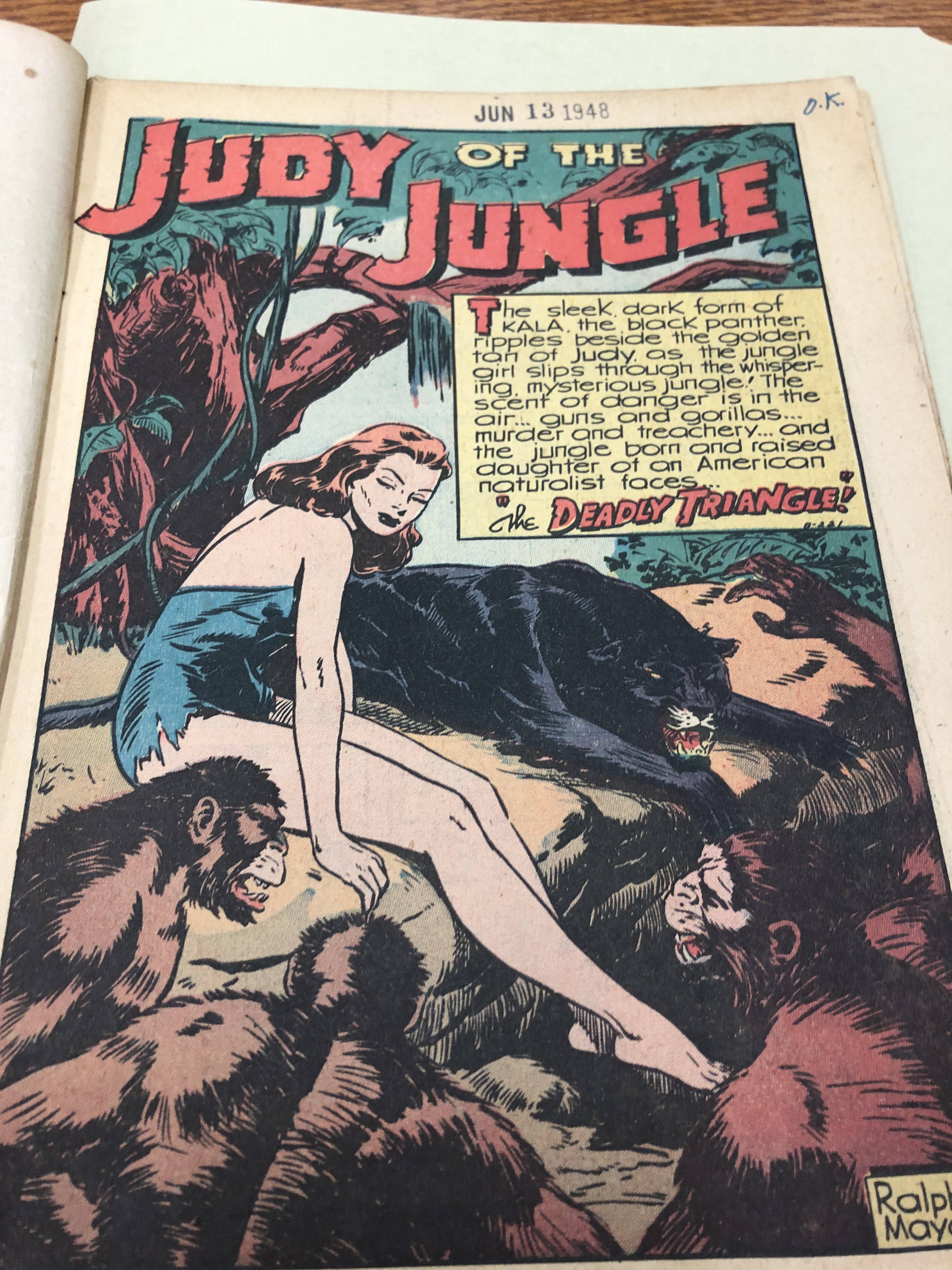After visiting the Special Collections section at the Hillman Library, I was initially disappointed in the lack of representation I noticed from the collection. Being a person of color, specifically an African-American, I found it troubling that throughout all of the books, journals, magazines, and newspapers, there seemed to be almost no black representation. By this I mean that within the texts, images, and first-hand accounts, none of these pieces of work within the collection attributed or represented the lives of African-Americans in America, or any persons of color. For some of the texts, I could understand why this was the case; some of the journals and early novels were written in the 1800s and early 1900s. During this time period, blacks were still slaves or had no form of representation. However, in the much later texts, such as the mid 20th century magazines, comics, and newspapers, blacks and people of color still did not have any representation, nor was there the mention of any black culture, people, or non-white themes.
It is well known that mid 20th century US history provides us with the the Harlem Renaissance, the integration of the military, prominent black and non-black, people of color musicians, writers and actors, and much more cultural diversity than earlier American history. Sadly, however, this was not represented within the collection of works we viewed. This was not a poor reflection on the universities Special Collection team or their many collections itself, but this was a poor reflection on the diversity of literature in America. This brought to my attention something that I never really realized was true: the racism within American literature. Interestingly enough, this realization made me wonder if anyone else noticed this, or if I were the only one.
These works were not intended for anyone other than the upper-middle class white man, and sometimes white woman. This was evident in many of the older newspapers and editorials, and especially in some of the novels that had covers of pale, white, girls with beautiful hair, big blue eyes, and the “perfect” body. In Judy of the Jungle, a comic strip about a jungle vixen who fights off bad guys within the “African amazon” with her sidekick leopard, clearly follows this trend of painting Judy as a tall, white woman with long, luscious, hair, a short, tight, fitting dress, along with a sensual personality. The comic itself, published in 1948, was supposedly written for teenage girls, since the comic company had been gaslighted for only writing comics for adolescent boys. However, this was clearly a lie, and it was evident to me due to the ads printed within the magazine which were mostly for guns, ammo, and other boy-friendly items. Also, because the comics heroine was a very sexually drawn wonder-woman type figure, this led me to believe that these comics were either written for the teen boy pleasure, making it sexist, or for teen girls envy in wanting to be like Judy. You can even see one ad (posted in the photograph below) that clearly says “Men!” while advertising belts in attempts to appeal to the older, male audiences to get them to buy the comic. Personally, I find this weird, considering the character of Judy is already portrayed very sexually, meaning that older men are supposed to find pleasure in reading this comic?? I don’t know, just makes me question what the companies true motives were in hyper sexualizing her character.
The comic itself, despite it being from the 40s, was in pretty good shape (no rips, blurry images, or stains). It was definitely something that was sent in the mail, which was apparent from the write-in ad that you could send back to the company to win some prize. Despite it being kept-up well in Special Collections, the comic itself was still very fragile. The pages were no longer white, but more of a taupe color, with a more vintage-style comic strip. Physically, the pages felt heavy to the touch, heavier than a normal piece of printer paper. Nonetheless, the comic showed a very similar resemblance to comics today, which I found interesting. Maybe the generic comic style blocks full of bubble letters and eye catching imagery has appealed to young audiences over generations, so there is no need for companies to deviate from that standard.
Going back to the sensual undertone in the story of Judy of the Jungle, the writers included very subtle diction that perpetuated this idea of Judy being a jungle vixen. Towards the beginning of the novel, the author uses very seductive language talking about Kayla, Judy’s panther sidekick. They say, “the sleek dark form of Kayla ripples beside the golden tan of Judy as the jungle girl slips through the whispering mysterious jungle…”(8). The words “sleek,” “golden tan,” and “slips through the whispering mysterious jungle”, along with the images on the page, personifies the jungle as something sexy and mysterious, when in actuality, it’s supposed to just be the jungle of Congo. The image on this page also very clearly places Judy on a rock, with her short blue dress and long legs, barely covers her body.
Interestingly enough, in reference to talking about lack of representation of blacks or people of color, Judy of the Jungle actually does have one small box that portrays the brown-skinned “jungle people” of Congo. The fact that there were even Congo natives who happened to be “jungle people” is stereotypically racist in itself, despite the fact that their skin color and facial features closely resembled the monkey’s found throughout the comic. But then again, this was the 40s, so it’s not very surprising. This, sadly, was the only real representation I saw within the pieces throughout Special Collections, and disappointingly enough, this one bit of representation happened to be misinformed and racist.
Overall, the plot in Judy of the Jungle follows similar plots of action and adventure in comics today, following a good “guy” fighting off bad guys to keep their home and its civilians (the jungle and animals) safe from evil.
PHOTOS BELOW (Sorry for the weird orientation. I wasn’t sure how to properly upload and arrange photos on here)
Cara Judkins





Hey Cara!
Reflecting back on our visit to Special Collections, I realized that you are absolutely right – the works we examined were almost entirely (if not entirely) portraying white protagonists and eurocentric ideas without including representation of any corresponding African American cultural norms. As you alluded to, this could very well be in part a result of the lack of prominent literature deemed culturally significant by those controlling the publishing companies back in the mid-twentieth century. I am not sure how much literature intended for a young audience was actually being produced and promoted back then, but I can’t think of any off the top of my head.
I found the ‘Judy of the Jungle’ character as you described her and from the images you included to be clearly sexualized and not something intended as a relatable female character. That particular comic seems very problematic – if not because of the sexualization of an adult woman’s image in what is supposed to be a young girl’s comic strip, then because of the depiction of the only people of color in the story as similar to monkeys. The Congo is obviously not a place where a random Judy-like white woman would typically be roaming around as if it’s her hometown, so I assume this to be a very inaccurate portrayal of the racial makeup of the region where this is supposed to have taken place, on top of the countless other problematic components.
-Marina S.
LikeLike